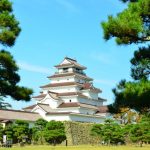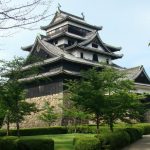Food you should try in Japan – Part 3
Here’s some more food you should try in Japan – classic (but must try) 10 “Izakaya Foods” – plus three more popular foods from locals. Make sure to add them to your list of things to eat while in Japan.
For traditional classics refer to “Food you should try in Japan Part 1” and for Japanese soul foods refer to “Food you should try in Japan Part 2”!
An Izakaya is a Japanese-style pub where you can enjoy a variety of alcohol (from classic beer, Asahi, Kirin and Sapporo or craft beers to shochu and sake) as well as a huge range of food options.
1. Edamame (枝豆)
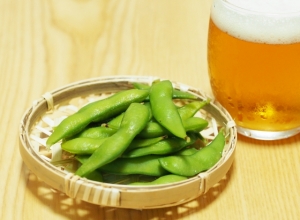
Edamame are immature soy beans, harvested before the beans go hard. They are cooked (simply boiled) and served in the pods with salt lightly sprinkled on the top. It’s the perfect snack for beer or as an entrée before an Izakaya dinner. (How to eat – use your hands to bring the pod up in to the front of your mouth and push a bean out into your mouth!)
2. Tofu dish: Hiya-yakko/Agedashi-dofu
(冷や奴/揚げ出し豆腐)
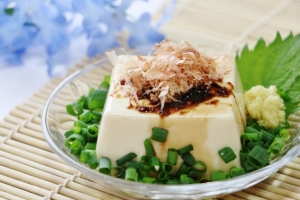
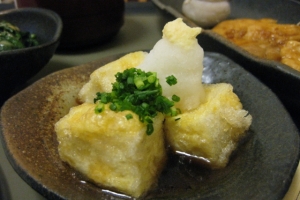
Tofu is soy bean curd, made of coagulated soy milk. There is a variety of softness such as silken, soft and firm.
Hiyayakko is simply cut into bite sized cubes, commonly with a topping of spring onion, grated ginger and bonito flakes. You can add a splash of soy sauce as you like. It’s generally silken tofu that’s used for hiyayakko.
Another popular tofu dish is agedashi-dofu (or agedashi-tofu). The soft tofu puts on a jacket of potato starch and is then deep fried. It’s served in dashi sauce with a topping of spring onion and grated radish. These are also perfect for entrée or as a side dish too!
3. Tsukemono (漬け物)
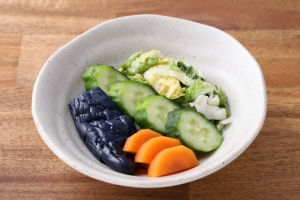
Tsukemono is pickled vegetables. It’s also great for a snack with drinks or a side dish.
Kyuri-no-ippon-zuke (pickled whole cucumber), nasu-no-ippon-zuke (pickled whole eggplant) or tsukemono moriawase (assorted tsukemono) would be a good idea.
4. Gyoza (餃子)
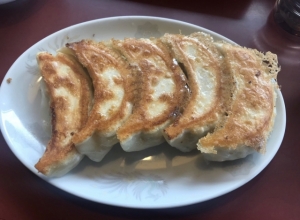
Well known as Japanese dumplings, gyoza is originally from China – but it’s slightly different to the Chinese style. Gyoza are filled with minced meat and vegetables and wrapped in a thin dough and crescent shaped with folds. The traditional Japanese gyoza filling consists of minced pork, nira (garlic chives), spring onion, cabbage, ginger and garlic. There are three main ways to cook gyoza – pan-fried, steamed and boiled. Pan-fried gyoza would be the most popular and common way to eat gyoza in Japan. Gyoza will be served with a dipping sauce which contains soy sauce, chill oil and vinegar. Oh well, again, gyoza is also one of the best mates of beer! And it’s a brilliant side dish for ramen. It’s a home cooked dish as well and many Japanese make gyoza at home. Would you like to learn how to make gyoza with a local? Check this out here!
5. Sashimi (刺し身)
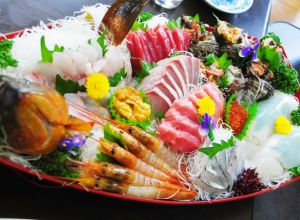
Sashimi is thinly sliced raw meat – particularly seafood (there’s also beef, horse and chicken – but I’ll talk about seafood here). It’s one of the most famous and iconic Japanese cuisines. Sashimi are usually presented with shredded daikon radish and garnished with shiso leaves on a plate and served with soy sauce with wasabi (and/or ginger/garlic – depending on the variety of sashimi pieces). You can choose whether to mix the wasabi (or other condiments) into the soy sauce, or add the wasabi (or the other relishes) directly onto a piece of sashimi and then lightly rinse into the soy sauce.
6. Chicken dish: Karaage/Yakitori/Nankotsu-karaage
(唐揚げ/焼き鳥/軟骨唐揚げ)
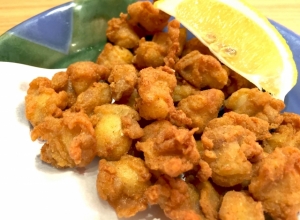
We’ve already listed karaage and yakitori in our previous posts and they are absolutely classic dishes! In addition to these, you may like to try deep fried or grilled tebasaki (chicken wings) or nankotsu karaage (which is deep fried chicken cartilage with a similar flavour to karaage)! Squeeze some lemon over the top or sprinkle lightly with salt (this is my way but it’s recommended!) then enjoy the crunchy texture.
7. Grilled fish (焼き魚)
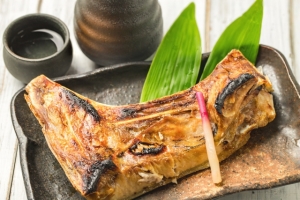
Grilled fish is also one of the classic Izakaya dishes that the locals relish. Some are served as a whole fish from head to tail and some are fillets. Some common Izakaya grilled fish dishes include hokke (Okhotsk Atka mackerel) or saba (mackerel) and some special dishes available include hamachi/buri kama (the collar of yellowtail) and seasonal fish (such as sanma (saury) in autumn).
Generally, the fish is grilled with a light amount of salt, so you don’t need to put any seasoning on. It’s usually garnished with grated daikon radish and lemon on the side. The best way to eat izakaya grilled fish is to firstly splash some soy sauce onto the grated daikon radish and squeeze some lemon over the fish. When you have a mouthful of fish, make sure to put a small amount of the soy sauced radish onto each mouthful.
8. Tako-wasa (たこわさ)

Tako-wasabi is also called tako-wasa and is one of the classic side dishes available at an Izakaya. It’s made of raw octopus (tako) flavoured with wasabi and other Japanese seasonings such as cooking sake and shio-koji (salt-marinated rice malt). As we have already mentioned on our other tako dishes in “Food you should try in Japan Part 2” (number 10), many Japanese love eating octopus. Tako-wasabi hit the stage of an Izakaya menu in the 1990’s. It was originated from a food for a batsu game – in which the loser of the game, or person who failed, has to do/play a penalty task (which is a typical Japanese culture thing!) nominated by a staff member of a food company. Due to its grotesque look and colour, nobody expected that it would be so tasty. But, it was surprisingly likable. Then the company started developing it as a new commercial product and distribute it to the public. In contradiction to the slimy looking contents, people fell in love with the crunchy texture and a wasabi punch flavour. It didn’t take long for tako-wasabi to become a classic menu item in an Izakaya! This might be a challenging food for you.
9. Dashimaki-tamago
(だし巻き卵)
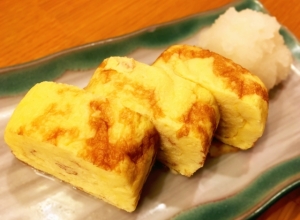
This dish is a type of Japanese omelette, like a rolled omelette which is commonly known as tamago-yaki. It’s made with whisked eggs and dashi (fish stock), sometimes with sugar added. Dashimaki-tamago is a simple dish, but rolling and making the layers of egg requires a little bit of technique! There are rectangular fried pans designed specifically for particularly cooking dashimaki-tamago! Would you like to try to cook tamagoyaki? Here, the English speaking local will teach you how to cook!
10. Ocha-zuke (お茶漬け)

Ocha-zuke is a traditional and simple Japanese rice bowl dish. Ocha (or cha) means tea and zuke (or tsuke) means submerge. It’s just rice with a few toppings on the rice with tea (or dashi soup/stock) poured onto it. Toppings are commonly umeboshi (pickled Japanese plums) and sake (salmon), also mentaiko (marinated cod roe with salt and chilli) and kim chi. Some fancy versions are sashimi cha-zuke and unagi cha-zuke!
Toppings include sprinkles of arare (rice crackers), small cut nori (seaweed) and mitsuba (Japanese parsley) garnishes on the top. The locals love having ocha-zuke after drinking at an Izakaya or even at home. The locals often say “Shime-no ocha-zuke” or (“shime-no ramen”) means ocha-zuke/ramen to call it a night.
Let’s have ocha-zuke and call it an Izakaya night!!
Here are three bonus must try dishes at an Izakaya –
Potato salad (ポテトサラダ)
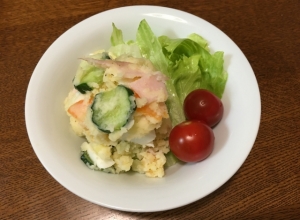
Japanese potato salad is made of mashed potato but leaving some chunky bits in, sliced cucumbers and carrots, eggs and sometimes ham or bacon. The ingredients and style are not too far from the western form. Japanese potato salad is flavoured with Japanese mayonnaise and some with a dash of vinegar or mustard to add a subtle touch to it. For wine, beer, Japanese sake… it suits any drink as a versatile side dish! Needless to say, everybody loves Japanese potato salad as home cooked dish as well!
Gyutan (牛タン)
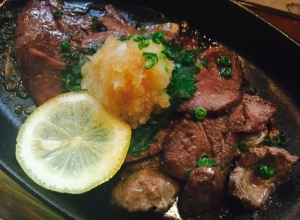
Gyutan is thinly sliced (or a bit thicker in Sendai – I’ll explain this more later!) beef tongue, grilled and eaten simply with a light sprinkle of salt and pepper, with a dash of lemon juice and is commonly served on an iron serving pan or a plate at an izakaya.
Beef tongue? Sounds grotesque? Nope (not for me)! There’s no peculiar smell or flavour, but it has a tender and pleasant chewy texture. Gyutan is a local speciality of Sendai, Tohoku and the northern part of the main island of Japan. There are many Gyutan restaurants in Sendai and it’s usually served as a thicker cut of beef tongue than an izakaya dish, with rice and soup along with other small side dishes.
Yakisoba (焼きそば)
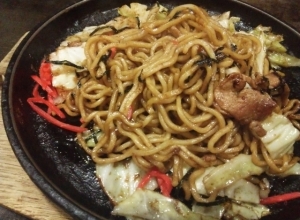
Yakisoba is a simple fried noodle dish. It’s cooked with thinly sliced pork, vegetables (cabbage, onion, carrots, bean shoots and green capsicum are common) and flavoured with yakisoba sauce (which is similar to BBQ sauce or Worcestershire sauce) and garnished with aonori (dried seaweed flakes) and beni-shoga (pickled ginger) on the top. Yakisoba is a favourite dish of the Japanese, regardless of age and sex, and is often cooked at home too. It’s also an iconic street food at events/festivals in Japan.
There is such a wide variety of simple yet great dishes available at an izakaya other than the above classic izakaya foods. These days, the menu at an izakaya generally has pictures (that’s a really great idea!). You could see the images and have some idea of what the dish would be like before you order most of the time. Izakaya is one of the best places to enjoy authentic Japanese food as well as some challenging food for you! I really hope you have a great Japanese food experience in Japan!
Meshiagare! (Dig in!)




